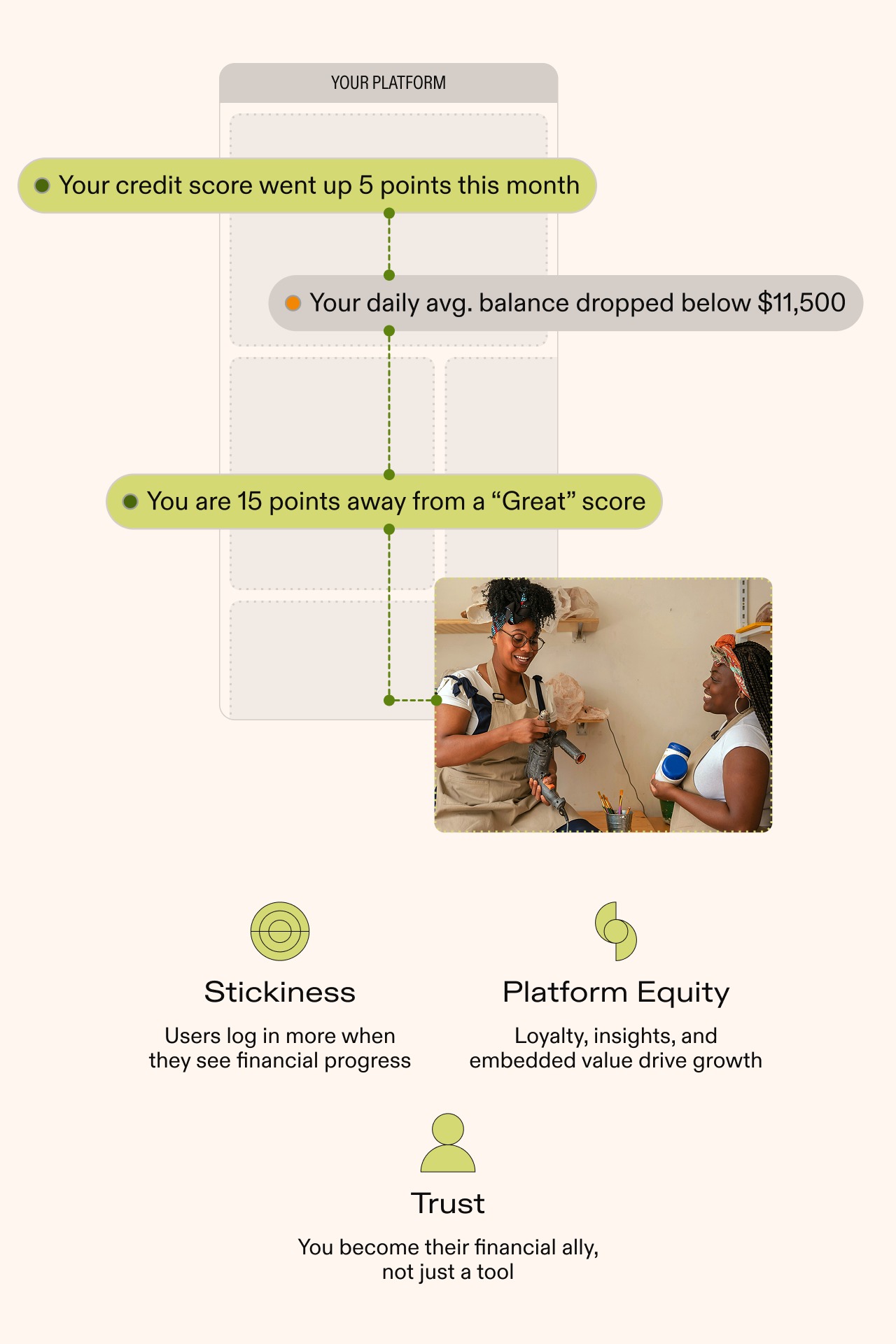From Utility to Lifeline: How Financial Tools Cement SMB Loyalty

Digital platforms—from SaaS, POS, and marketplaces to neobanks and fintechs—depend on small businesses for growth. Yet churn rates remain stubbornly high, with up to 76% annual attrition in some verticals. The primary culprit? Financial instability. Most SMBs operate on thin margins, lack credit awareness, and have fragmented tools. This leads to missed payments, business failure, and cancelled subscriptions.
But there's a fix, and it's not just better software. It's embedding financial wellness tools directly into the platform experience. When platforms help SMBs access capital, monitor credit, and make data-driven decisions, they shift from being a utility to being essential. In this way, your platform transforms from just another vendor into a financial lifeline, a trusted partner integral to their day-to-day survival and growth.
Embedded financial insights aren’t just a feature. It’s the connective tissue that builds lasting engagement, trust, and loyalty.



01 — The Challenge: SMBs Are Leaving, and It’s Costing You
Customer acquisition costs (CAC) are rising—up 65% year over year. Meanwhile, 20% of retail SMBs churn annually, and SaaS platforms can see monthly churn rates as high as 7%. Every lost customer is a sunk cost. And replacing them is getting harder.
The economics are unforgiving: acquiring a new customer can cost 5-25x more than retaining an existing one. A modest 5% boost in retention can increase profits by up to 95%.
Platforms are hemorrhaging engagement by failing to support SMBs when they need it most. In a market where every dollar counts, survival is a daily concern. Platforms that step in to steady the ship become more than tools—they become anchors.
02 — The Root Problem: Financial Health Is a Blind Spot
85% of small businesses don’t know their credit score. Many can’t access funding when they need it most. Their finance stacks are fragmented, with critical data siloed across accounting software, banks, and spreadsheets.
Financial stress is more than operational; it’s emotional. 58% of younger SMB owners report anxiety over finances. This stress impairs decision-making and heightens churn risk. Without visibility or support, an unexpected bill or delayed invoice can break a business. Platforms that fail to intervene risk becoming part of the fallout.
03 — The Solution: Embed Financial Wellness Into Your Platform
To truly support SMBs and reduce churn, platforms must evolve into Small Business Operating Systems (SBOs). Here's a strategic overview of the foundational tools that comprise an embedded financial wellness stack:
- Business Credit Monitoring: Provide visibility into credit scores and risk factors. Early alerts on negative changes empower SMBs to address issues proactively.
- Cash Flow Dashboards: Aggregate real-time data from banking, accounting, and sales channels to offer a comprehensive financial snapshot.
- Embedded Financing: Deliver frictionless access to working capital, equipment financing, and lines of credit with in-context offers and instant approvals.
- Behavior-Based Rewards: Encourage healthy financial behaviors through incentives like lower rates, cashback, or discounts.
These tools aren't just nice-to-haves. They're fundamental in turning your platform into a trusted financial ally.
04 — The Proof: Financial Tools Increase Stickiness and Revenue
Platforms embedding financial tools are seeing exponential results:
- We’ve seen 25–40% of SMB users activate Business Credit Monitoring when offered by a trusted partner — and early adopters are more likely to qualify for funding, build credit, and stick with the platform that helped them do it.
- Roofstock saw 3.5x higher retention from users of its cash management tools.
- Vendasta data shows that platforms offering four services see 80% retention over two years vs. 30% with just one.
These aren’t just case studies—they’re a mandate. Financial wellness drives loyalty, increases engagement, and creates defensible differentiation.
05 — What Platform Partners Should Do Next
To become indispensable, platform partners must think beyond transactions and reimagine their role in the SMB lifecycle. Here's how to start:
1. Embed Financial Tools Natively
Don't make users click out to third-party tools. Integrate financial services into the workflows your users already rely on—dashboards, order screens, and CRM interfaces. Contextual access boosts engagement and utility.
2. Offer Tiered, Transparent Financial Solutions
Start with freemium credit monitoring to build awareness. Then introduce personalized financing options as SMBs grow. Include tools for budgeting, forecasting, and payment flexibility. Use progressive tiers to align with the customer's business maturity.
3. Harness Real-Time Data for Smart Recommendations
Utilize embedded APIs to gather behavioral and financial data. Use this to offer timely insights: "Your margins are dipping this month—consider a bridge loan." or "You’re pre-qualified for better terms based on your payment history."
4. Build Trust Through Proactive Support
Train support teams to flag financial risks before they lead to churn. Alert users to anomalies, offer credit-building coaching, and showcase how the platform is actively working on their behalf. Trust builds retention.
5. Monetize via Revenue Share and Engagement Expansion
Every financial interaction is a monetization opportunity. Offer services that share upside—interchange fees, financing commissions, premium insights subscriptions. More importantly, embedded finance drives deeper customer engagement and longer-term platform stickiness. The goal isn’t just to reduce churn. It’s to create a platform so integrated into the SMB’s financial DNA that leaving it would feel like losing a business partner.
Conclusion: Build with Their Balance Sheet in Mind
The platforms that win will be the ones that stop thinking like vendors and start acting like allies. When SMBs succeed, platforms succeed.
Financial health isn’t a bonus. It’s the baseline. Make it core to your value prop—and watch churn drop, loyalty rise, and new revenue streams emerge.








_Nick_Fancher_Photos_ID6069.jpg)



